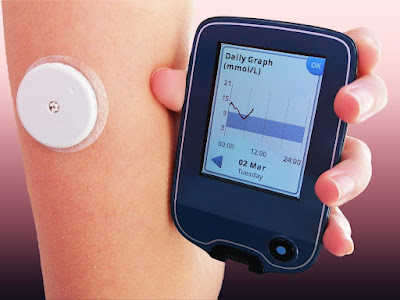Introduction to Continuous Glucose Monitoring Devices
 |
| Continuous Glucose Monitoring Devices |
Continuous glucose monitoring (CGM) devices have revolutionized the management of diabetes by allowing real-time monitoring of glucose levels throughout the day and night. These devices provide far greater insights into how different foods, medications, activities and stresses affect blood sugar compared to intermittent finger-prick readings.
What are CGM devices?
CGM devices are small wearable devices that work continuously to detect glucose
levels in the interstitial fluid just under the skin. The devices consist of a
small sensor inserted just under the skin, usually on the abdomen or upper arm.
The sensor measures glucose levels every few minutes via a tiny filament
inserted into the interstitial fluid. The readings are wirelessly transmitted
to a receiver or smartphone app where the user can view their real-time glucose
levels as well as trends over the past few hours. Most CGM systems can monitor
glucose levels for 5-14 days before requiring sensor replacement.
How do CGM devices work?
CGM sensors work using electrochemical reaction technology to measure the
glucose concentration in interstitial fluid. The sensor filament contains an
enzyme called glucose oxidase that reacts with glucose. This reaction produces
an electronic current that is proportional to the glucose concentration. The
sensor continuously transmits this current data wirelessly to the receiver or
app. Advanced algorithms then convert the current data into estimated blood
glucose readings. The key advantage of CGMs compared to finger-prick readings
is that they can detect glucose levels continuously across day and night
without requiring painful finger-pricks.
Benefits of CGM over Finger-prick
Monitoring
The main benefits of CGM compared to traditional finger-prick glucose
monitoring include:
- Insulin Adjustments: Continuous
Glucose Monitoring Devices provides critical insights into how
different foods, activities and medications impact blood sugar levels over
time. Users can proactively adjust insulin doses based on trends rather than
lagging finger-prick readings. This improves glycemic control.
- Detects Hyper/Hypoglycemia Earlier: The real-time data from CGM allows users
to detect and treat episodes of hyperglycemia (high blood sugar) and
hypoglycemia (low blood sugar) much earlier before they become dangerous.
- Improves Glycemic Control: Multiple clinical studies have consistently shown
CGM use significantly reduces A1c levels compared to finger-prick testing
alone, indicating improved average blood sugar control. Lower A1c is associated
with lower risk of diabetes complications.
- Peace of Mind: Not having to do painstaking finger-prick tests multiple times
per day reduces the daily burden and stress of diabetes management. CGM
provides convenient, automatic monitoring of glucose throughout waking and sleeping
hours.
- User-Adjustable Alerts: Modern CGM systems allow users to set customizable
alerts for high/low glucose thresholds. Users receive alerts directly on their
smartphone or receiver when levels go outside the target range.
Types of CGM Devices Available
There are two main categories of CGM systems available on the market:
RT-CGM Systems (Real-Time CGM)
- Provide real-time glucose readings every few minutes via wireless connection
to a receiver or app. Popular RT-CGM brands include Dexcom G6 and Abbott's
FreeStyle Libre systems.
- Considered the gold standard for advanced diabetes management due to their
frequent, real-time readings and customizable alerts.
- Best used for close glucose monitoring and insulin adjustment throughout the
day.
- Require sensor insertion every 5-14 days depending on brand.
- More expensive upfront cost compared to retrospective systems.
FGM Systems (Flash Glucose Monitoring)
- Also called retrospective or "flash" CGM systems.
- Provide glucose readings via a scanning method instead of automatic wireless
updates.
- Scanning the sensor with a reader provides the last 8 hours of glucose data
and trend arrows.
- Only brand currently available is Abbott's FreeStyle Libre 2.
- Approved as a standalone device without needing fingers-pricks for treatment
decisions.
- Sensor lasts 14 days before replacement.
- Lower upfront cost than RT-CGM but less real-time data advantages.
Improving Access and Insurance Coverage
In the past, the high upfront costs of CGM devices limited their adoption and
accessibility for many diabetes patients. However, increasing clinical evidence
and lobbying efforts have led to major improvements in insurance coverage in
recent years.
Most private insurers now provide at least partial coverage for CGM supplies.
Medicare part B also expanded national CGM coverage in 2021 for all adult
beneficiaries with type 1 diabetes or pregnant beneficiaries with type 1 or 2
diabetes.
Improved insurance access means more patients can benefit from the
transformative technology of CGM. Wider adoption will further advance diabetes
research and lead to even more connected, automated diabetes management
solutions in future. CGM has truly entered the mainstream as a standard of care
for diabetes.
Get More Insights on this Topic- https://www.newswirestats.com/continuous-glucose-monitoring-devices-lifeline-for-diabetic-patients/



Comments
Post a Comment